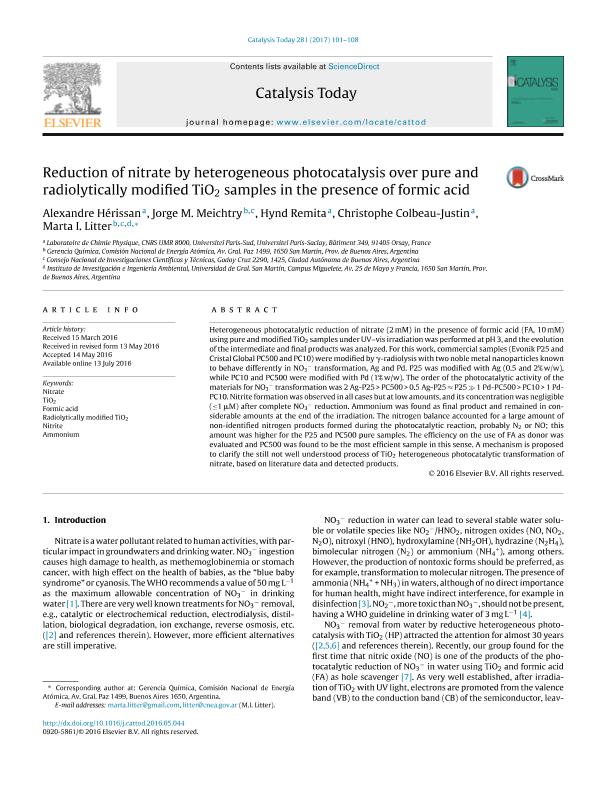Mostrar el registro sencillo del ítem
dc.contributor.author
Hérissan, Alexandre
dc.contributor.author
Meichtry, Jorge Martin

dc.contributor.author
Remita, Hynd
dc.contributor.author
Colbeau Justin, Christophe
dc.contributor.author
Litter, Marta Irene

dc.date.available
2018-07-25T18:31:05Z
dc.date.issued
2017-03
dc.identifier.citation
Hérissan, Alexandre; Meichtry, Jorge Martin; Remita, Hynd; Colbeau Justin, Christophe; Litter, Marta Irene; Reduction of nitrate by heterogeneous photocatalysis over pure and radiolytically modified TiO2 samples in the presence of formic acid; Elsevier Science; Catalysis Today; 281; 3-2017; 101-108
dc.identifier.issn
0920-5861
dc.identifier.uri
http://hdl.handle.net/11336/53110
dc.description.abstract
Heterogeneous photocatalytic reduction of nitrate (2 mM) in the presence of formic acid (FA, 10 mM) using pure and modified TiO2 samples under UV–vis irradiation was performed at pH 3, and the evolution of the intermediate and final products was analyzed. For this work, commercial samples (Evonik P25 and Cristal Global PC500 and PC10) were modified by γ-radiolysis with two noble metal nanoparticles known to behave differently in NO3− transformation, Ag and Pd. P25 was modified with Ag (0.5 and 2% w/w), while PC10 and PC500 were modified with Pd (1% w/w). The order of the photocatalytic activity of the materials for NO3− transformation was 2 Ag-P25 > PC500 > 0.5 Ag-P25 ≈ P25 ≫ 1 Pd-PC500 > PC10 > 1 Pd-PC10. Nitrite formation was observed in all cases but at low amounts, and its concentration was negligible (≤1 μM) after complete NO3− reduction. Ammonium was found as final product and remained in considerable amounts at the end of the irradiation. The nitrogen balance accounted for a large amount of non-identified nitrogen products formed during the photocatalytic reaction, probably N2 or NO; this amount was higher for the P25 and PC500 pure samples. The efficiency on the use of FA as donor was evaluated and PC500 was found to be the most efficient sample in this sense. A mechanism is proposed to clarify the still not well understood process of TiO2 heterogeneous photocatalytic transformation of nitrate, based on literature data and detected products.
dc.format
application/pdf
dc.language.iso
eng
dc.publisher
Elsevier Science

dc.rights
info:eu-repo/semantics/openAccess
dc.rights.uri
https://creativecommons.org/licenses/by-nc-sa/2.5/ar/
dc.subject
Ammonium
dc.subject
Formic Acid
dc.subject
Nitrate
dc.subject
Nitrite
dc.subject
Radiolytically Modified Tio2
dc.subject
Tio2
dc.subject.classification
Otras Ciencias Químicas

dc.subject.classification
Ciencias Químicas

dc.subject.classification
CIENCIAS NATURALES Y EXACTAS

dc.title
Reduction of nitrate by heterogeneous photocatalysis over pure and radiolytically modified TiO2 samples in the presence of formic acid
dc.type
info:eu-repo/semantics/article
dc.type
info:ar-repo/semantics/artículo
dc.type
info:eu-repo/semantics/publishedVersion
dc.date.updated
2018-07-25T13:52:47Z
dc.journal.volume
281
dc.journal.pagination
101-108
dc.journal.pais
Países Bajos

dc.journal.ciudad
Amsterdam
dc.description.fil
Fil: Hérissan, Alexandre. Centre National de la Recherche Scientifique; Francia. Université Paris Sud; Francia
dc.description.fil
Fil: Meichtry, Jorge Martin. Consejo Nacional de Investigaciones Científicas y Técnicas; Argentina. Comisión Nacional de Energía Atómica; Argentina
dc.description.fil
Fil: Remita, Hynd. Centre National de la Recherche Scientifique; Francia. Université Paris Sud; Francia
dc.description.fil
Fil: Colbeau Justin, Christophe. Centre National de la Recherche Scientifique; Francia. Université Paris Sud; Francia
dc.description.fil
Fil: Litter, Marta Irene. Consejo Nacional de Investigaciones Científicas y Técnicas; Argentina. Comisión Nacional de Energía Atómica; Argentina. Universidad Nacional de San Martín. Instituto de Investigación en Ingeniería Ambiental; Argentina
dc.journal.title
Catalysis Today

dc.relation.alternativeid
info:eu-repo/semantics/altIdentifier/doi/https://dx.doi.org/10.1016/j.cattod.2016.05.044
dc.relation.alternativeid
info:eu-repo/semantics/altIdentifier/url/https://www.sciencedirect.com/science/article/pii/S0920586116304059
Archivos asociados
